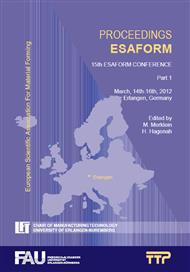p.131
p.137
p.143
p.151
p.157
p.163
p.169
p.175
p.181
Computer Aided Design of Manufacturing of Fasteners - Selection of the Best Production Chain
Abstract:
Computer aided design of the manufacturing technology for the fasteners is presented the paper. The particular objectives of the work were twofold. The first objective is evaluation of applicability of various materials for fasteners. Analysis of different technological variants is the second objective of the research. In the material part, bainitic steels are considered as an alternative for the commonly used carbon-manganese steels. This is a continuation of [1,2]. Possibility of elimination of the heat treatment was evaluated. Main features of the new generation of bainitic steels are discussed briefly in the paper. Rheological models for all steels investigated in the project were developed. The models were implemented into the finite element code for simulations of drawing and multi stage forging. Simulations of various variants of manufacturing chain were performed and the best alternative was selected. Criteria for the selection composed dimensional accuracy and tool life. Industrial trials were performed for the selected cycle and the efficiency of this cycle was evaluated. Finally, the optimization task was formulated. However, solution of the optimization problem is costly at this stage and improvement of the efficiency of the formulation will be the objective of further research. References 1. Kuziak R., Skóra M., Węglarczyk S., Paćko M., Pietrzyk M., Computer aided design of the manufacturing chain for fasteners, Computer Methods in Materials Science, 11, 2011, 243-250. 2. Kuziak R., Pidvysots’kyy V., Węglarczyk S., Pietrzyk M., Bainitic steels as alternative for conventional carbon-manganese steels in manufacturing of fasteners - simulation of production chain, Computer Methods in Materials Science, 11, 2011, 443 – 462.
Info:
Periodical:
Pages:
157-162
Citation:
Online since:
February 2012
Authors:
Keywords:
Price:
Сopyright:
© 2012 Trans Tech Publications Ltd. All Rights Reserved
Share:
Citation:


